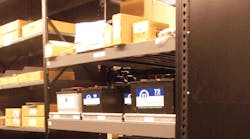Maintenance technicians always try to reduce downtime, but inefficient parts storage can prolong their search for the right replacement parts. That can result in a loss of thousands of dollars in production and labor.
Parts storage and maintenance capacity must evolve as new part sizes, shapes, weights, quantities and configurations are introduced. Such a flexible storage system starts from raw shelving and evolves as needed.
“The goal in maintenance is to strive for zero production downtime, but that depends on getting the right parts into the hands of technicians for needed repairs as soon as possible,” says Jeremy Miller, a DC maintenance foreman for JBS USA LLC’s Marshalltown, Iowa facility, a subsidiary of JBS, a $30 billion processor of beef and pork. “Delay in locating the right parts in storage translates into unnecessary downtime.”
The Marshalltown facility carried a production parts inventory of over $1 million, mostly in a central parts area, with parts ranging from tiny nuts, bolts and screws to gears, sprockets and cabling to motors, chain drives, and sensitive electronic boards.
The facility previously used an open rack, cabinet and bin storage system for parts storage. The shelves were essentially fixed, and because nothing would fit the storage space exactly, technicians had to search for a spot to put the items.
“If the parts didn’t fit, we had to store the items in multiple locations, or buy entire new racks when all we may have wanted was a larger drawer to keep related parts together,” says Miller. “Parts for certain equipment ended up being scattered in as many as ten different locations.”
Miller turned to a flexible modular storage system (V-Grip by Equipto, www.equipto.com), which starts as raw shelving and allows parts managers to adapt and create denser and denser storage capacity as marketplace, budget, or storage needs change. Shelves, drawers and other accessories can be interchanged in the shelf cavity.
The modular storage system begins with heavy-duty uprights, and top, bottom, back and side panels. Shelves from 400 lbs. to over 1000 lbs. capacity can be added and adjusted at 1½” increments for storage of bulk items and items of different sizes. For more efficient storage of small to medium sized parts, drawers 3” to 13½” in height can be added, along with in-drawer divider sets or shelf dividers to keep small parts from mixing. For more security, locking steel and see-through doors (for visual inventory capability) in various combinations can be added anytime.
“We were able to consolidate our spare production parts in equipment-specific locations in a small central parts room,” says Miller. “This left enough room for me to build a small office inside, which further improved inventory control. Now instead of our techs having to search for spare parts in 10 or more spots for a single repair job, they can go to one equipment-specific location to get the parts they need for a job. It has cut part retrieval time for repair jobs about 70%, from about 10 minutes per job down to about 3 minutes per job. This can add up to tens of thousands of dollars or more in annual savings.”
If adequate ceiling clearance is available, storage capacity can be increased with a freestanding or shelf supported mezzanine.
Del Williams is a technical writer based in Torrance, Calif.



